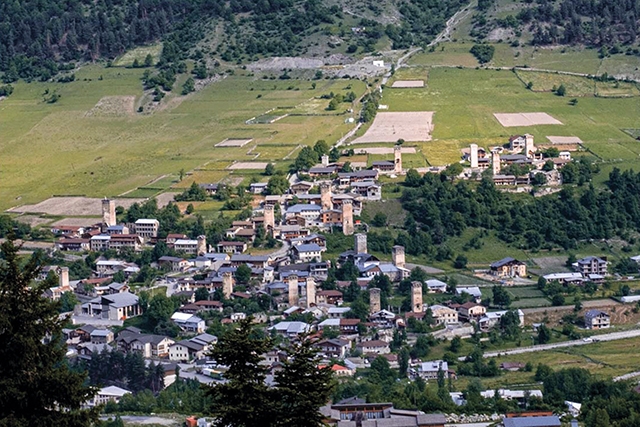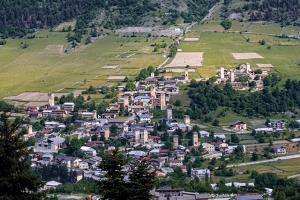Losing Svaneti - the Architectural Heritage of the Region
Svaneti - A Slogan of the Saakashvili Period Profoundly Changes the Architectural Heritage of the Region
The push for the development of tourism, as currently seen in Upper Svaneti, came from the former Georgian President Mikheil Saakashvili. The World Heritage status of the village of Chazhashi from the village community Ushguli, which was achieved in 1996, was intended to attract international tourists to Svaneti. In 2019, the number of tourists had already reached about 150,000 per year. With a controversial new building project in Mestia next to Seti Square, Saakashvili presented an architectural style that was to changed Svaneti.
The Swiss chalet style is reshaping the Svan ‘City of Towers’
The relationship between tradition and modernity is generally tense in Georgia. Mestia, the administrative center of Upper Svaneti, is a particularly harsh example in this regard. In the center, Mestia meanwhile hardly differs from other tourist base stations at the foot of the mountains of other holiday countries. Around Seti Square, it looks like any mountain village in the Alps due to its new buildings.
The inhabitants have fully adapted to the needs of the visitors who come here for hiking in summer or skiing in winter. Breakfast cafés and restaurants are lined up with small shopping markets, shops of day-trip operators and rental shops for hiking and ski equipment. There is a constant wooing for the arriving guests.
San Gimignano, the Tuscan city of towers, has been Mestia's twin town since 1975. In contrast to San Gimignano, classical architecture is hardly to be found in the center of Mestia today. But even in the peripheral areas, it is dwindling due to the conversion of old buildings into guest houses. The accommodation, restaurants, bars and shops is continuously increasing: in 2019, there were already more than 300 providers of accommodation.
Along the main street, buildings in the Swiss "chalet style" dominate. These consist of a ground floor built with quarry stone, and on the first floor wooden balconies, which are not typical for either Svaneti or Georgia. In general, it can be said that there are no limits to the builders' creativity. A lot is in flux: some roof terraces from last year already present themselves the following year as closed floors with beds for guests. However, some shell construction does not develop even after years: the interest rates for loans are astronomically high in Georgia. If there is no noticeable success in the first year, many hopes for an income in tourism remain unfulfilled, while the heavy burden of debt remains.
Fatal developments in ski tourism in Svaneti
The Hatsvali Ski Resort had already been developed in the Soviet era with a small lift system, but it was hardly used. At that time, mainly long-distance hikers and mountaineers on cross-republic paths visited Svaneti. The fame of that time is still present in Russia today. Despite the fact that President Putin stopped air traffic in 2019 in protest against the massive Russian-critical attitude of a new political protest movement, winter tourists from Russia still represent the largest group of visitors to Svaneti.
The journey from Central Europe doesn’t take too long either, calculated in hours. However, the way to Svaneti via motorways and tunnels, which could bring large masses of people into the high mountains, is still a long way off, perhaps fortunately for the region.

Reproduction of an undated Photo of the 1960s showing Chvibiani and Zhibiani and taken from a room of the Solomon guest house in Chvibiani, which captures the principal phase of reconstruction during the Soviet period, during which, following the elder interlocutors, over half of the uninhabited towers were demolished for building materials

The same view, taken today; a check at the site confirms that since the previous photo was taken, only one further tower has been lost, to collapse.
Reinhold Messner, an icon of mountain sports, visited Mestia in 2017 on the invitation of the Georgian government. He made Georgia the "generous" proposal to build a "Reinhold Messner Mountain Museum" near the top station at Café Zuruldi, with a view over Mestia, on condition that the Georgian state fully finances the museum and accepts Messner's architects along with all the plans. There Messner said that he wanted to tell the "true story" of the Caucasus. He predicted a bright future for winter tourism in Georgia because the Alps would soon be lacking snow. However, ski tourism, as propagated by Messner in two advertising videos, will hardly be able to contribute to sustainable economic development. After all, ski tourists from Europe appreciate not only the exceptional nature of the Svaneti mountain world and the archaic architecture, but above all the fact that skiing is cheap there.
Already for the creation of the Tetnuldi ski area in particular, enormous mass movements were necessary due to the harshness of the mountain range, which devoured large agricultural areas, fields for which the population has not been compensated to this day. For Svaneti, moreover, the same should apply as elsewhere: a ban on off-piste skiing and a sustainable transfer of income to the development of the infrastructure needed locally, with an expansion of an ecologically compatible touring ski offer.
Instead, more and more new hotels and guesthouses have been built in recent years to cater for winter tourists. There was a regular transport of skiers to Ushguli even in winter 2019/20, made possible by the expansion of the road. What skiers appreciate most about Svaneti is that nobody there regulates skiing off-piste.
But Svaneti is above all a highly sensitive high mountain region, which is one of the last refuges for long lost species of flora and fauna elsewhere, which is why skiers should actually forbid themselves from skiing off-piste, not least for the fact that the hay and pasture areas and their fragile soils are damaged, which the population urgently needs for self-sufficiency.
Ushguli - Cause of the boom and perhaps soon the decline of the tourist attraction of Svaneti
The international tourism industry regards Ushguli as an ideal image of Svan mountain villages. In Ushguli, you encounter a cultural area in which, as described in the UNESCO award, the architecture of medieval origin is combined with an impressive, authentic mountain landscape in a unique way. All this has been preserved since the people there still practice traditional mountain farming. However, the UNESCO award has led to a change in this cultural area due to the influx of tourists.
Using the village community of Ushguli as an example, a comparison of the few surviving photographs, which presumably date from the late 1960s and early 1970s, shows that the intervention during the Soviet era was the most significant, especially in the villages of Chvibiani and Zhibiani, while the village of Chazhashi was protected as the Ushguli-Chazhashi Museum from 1971 onwards. Due to the structural changes during the Soviet era, UNESCO refused to include the entire village community on the World Heritage List. Nevertheless, according to the World Heritage Commission, structural changes in Murkmeli, Chvibiani and Zhibiani may only be carried out with state permission, as they belong to the buffer zone around Chazhashi.
Even if no precise restrictions are set, the UNESCO Commission points out in the existing documents that structural alterations generally jeopardize the World Heritage status. This would ultimately affect the entire mention of Svaneti and Georgia within the UNESCO system. Svaneti itself does not have World Heritage status. Besides, most of the remaining towers outside the UNESCO district of Chazhashi are in danger of collapsing.

Many residents do what they can, but here too the chalet style prevails: A self-initiated renovation of a residential and stable building from the 1950s in Ushguli.
In August 2019, some inhabitants of Ushguli blocked the road to Mestia for the first time to protest against the government's inactivity. The village community was not accessible for tourists for hours. Svaneti, they said, was advertised by the government as a tourist development region, but on the other hand, the families were not supported in preserving the architectural, cultural heritage.
Meanwhile, in Ushguli, both the architectural heritage and the cultural landscape surrounding it have undergone such drastic changes within a few years that there are apparent differences between the situation on-site and UNESCO's justification for the allocation of World Heritage status. It would not be the first time that the UNESCO Committee would be in the position to limit the scope of the World Heritage Site in Georgia, or to withdraw it from an entire ensemble of buildings. Such an attitude on behalf of UNESCO was evident in the dispute over the restoration of the Bagrati Cathedral in Kutaisi.
To date, the Georgian state has not developed a sustainable management plan that would guarantee the preservation of the buffer zone (buildings, landscape conservation, sustainable agriculture) by involving the local administration and the needs of the local population. This challenge cannot be met by the inhabitants of Ushguli alone without external financial support. After all, this buffer zone includes all other villages and a considerable part of the cultural landscape surrounding them.
Thus, what in remote high mountain regions in general and elsewhere in the Caucasus is seen as development potential against the background of a rich cultural and ecological heritage, could turn into its opposite in Ushguli. Hiking and cultural tourism, which, also attracted by the World Heritage status, flows to Svaneti, has been leading to a revival of old villages for some years now, at least in summer. It is precisely this tourism that could also lead to the removal of the World Heritage status.
Finally, most holidaymakers lack information about the real economic, social and also ecological conditions on-site to make a sustainable choice and the use of a sustainable service possible. Without summer and winter tourism, there will be no development in the region in the long run. But as long as only the local providers profit economically, who are already better off, we will hardly see the whole region being able to recover from the effects of tourism.
A neo-liberal tourism policy without supportive state intervention has led to the fact that most families can only operate tourism as an extended subsistence economy. Accommodation prices are far too low for small providers to be able to preserve the medieval architecture.
By Stefan Applis
Stefan Applis is a professor of geography in Germany and has been working in Svaneti since 2015, working together with Nino Tserdediani, the director of the Svaneti Museum of History and Ethnography.
MAIN PHOTO: Mestia - still known as the Georgian 'City of Towers'












